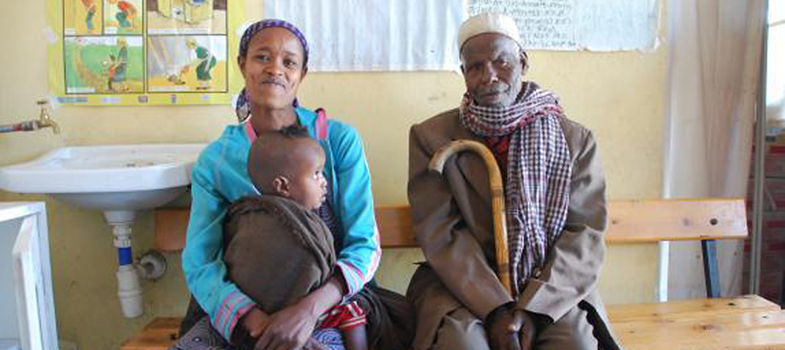13.1.3 Follow-up care for ear problems
If you classified a child with either acute or chronic ear infection you need to tell the mother to return for a follow-up visit five days after her first visit. Box 13.2 below outlines what follow-up care should be given to the child.
Box 13.2 Reassess for ear problems
Measure the child’s temperature.
Treatment
- If there is tender swelling behind the ear or high fever (38.5oC or above), refer the child urgently to hospital.
- Acute ear infection: if ear pain or discharge persists, treat for five more days with the same antibiotic. Tell the mother to continue wicking to dry the ear, and to come for a follow-up visit in five days.
- Chronic ear infection: check that the mother is wicking the ear correctly. Encourage her to continue the ear wicking and giving the child topical quinolone ear drops. Discuss with her the importance of keeping the child’s ear dry.
- If no ear pain or discharge, praise the mother for her careful treatment. If she has not yet finished the five days of antibiotic, tell her not to stop until the end of the fifth day.
You are now going to do an activity which will check your understanding of what you have learned so far.
Activity 13.1
Case Study 13.1 and Case Study 13.2 describe children who have ear problems. In the box after each case study make notes on the following:
- The steps would you take to assess each child’s ear problem.
- How you would classify the ear problem in each case.
- What treatment you would give the child in each case.
If you need to remind yourself of the different classifications, either use the wall chart or your chart booklet at your health post, or refer to the materials that you have already looked at in this study session.
Case Study 13.1 Mebrat
Mebrat is three years old. She weighs 13 kg. Her temperature is 37.5°C. Her mother came to the clinic today because Mebrat has felt hot for the last two days. The health worker checked and found no general danger signs.
Next the health worker asked about Mebrat’s ear problem. The mother said she was sure Mebrat had no ear pain, but that she had seen discharge coming from Mebrat’s ear for about three weeks. The health worker saw pus draining from the child’s ear. She felt behind the child’s ears and found tender swelling behind one ear.
Write your notes in the space below on how to assess, classify and treat Mebrat’s ear problems
Case Study 13.2 Danso
Danso is 18 months old. She weighs 9 kg. Her temperature is 37°C. Her mother says that Danso had discharge coming from one of her ears for the last three days.
Danso does not have any general danger signs. She does not have cough or difficult breathing. She does not have diarrhoea and she does not have fever.
The health worker asked about Danso’s ear problem. The mother said that Danso does not have ear pain, but discharge has been coming from one ear for three or four days. The health worker saw pus draining from the child’s right ear. She did not feel any tender swelling behind either ear.
Write your notes in the space below on how to classify and treat Danso’s ear problem
Comment
Clearly, the children in both cases have ear problems. You should have noted that Mebrat has chronic ear infection because the duration of the discharge from the ear is over two weeks. In addition there is a tender swelling behind one of her ears which indicates that she has mastoiditis which, as you learned, is a serious complication of ear infection. Mebrat therefore needs to be referred urgently after the first dose of an antibiotic has been administered. There is no need to waste time by showing her mother how to clean the ear.
In the case of Danso the duration of ear discharge is only three days. There is no swelling behind the ear. You should therefore have classified Danso as having acute ear infection. She should be treated with cotrimoxazole twice per day for five days. You should advise the mother to come back for a follow-up visit in five days. You should also assess Danso for symptomatic HIV.
13.1.2 Classify and treat ear problems
